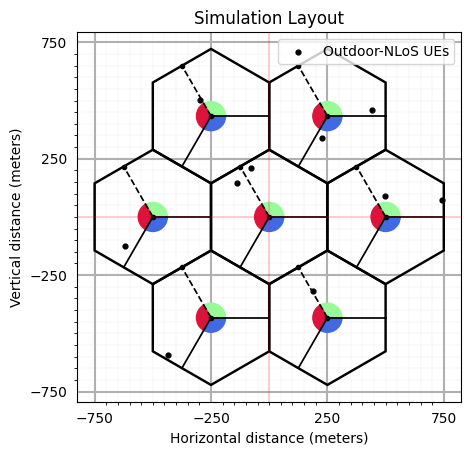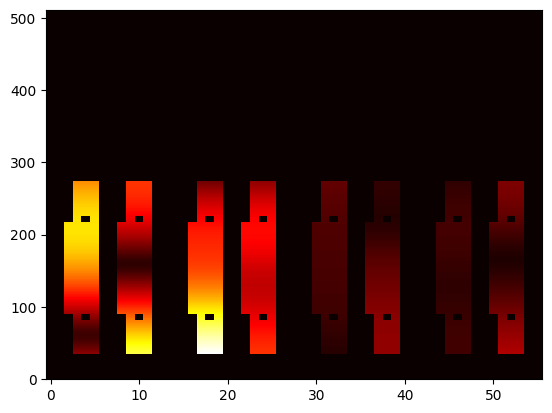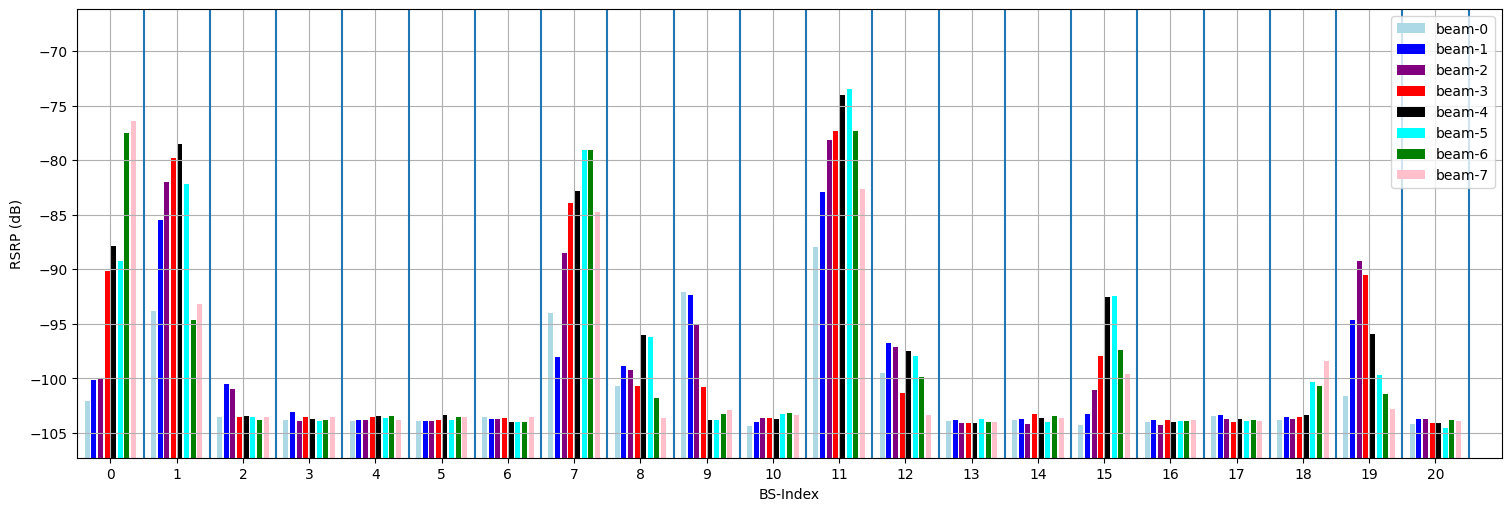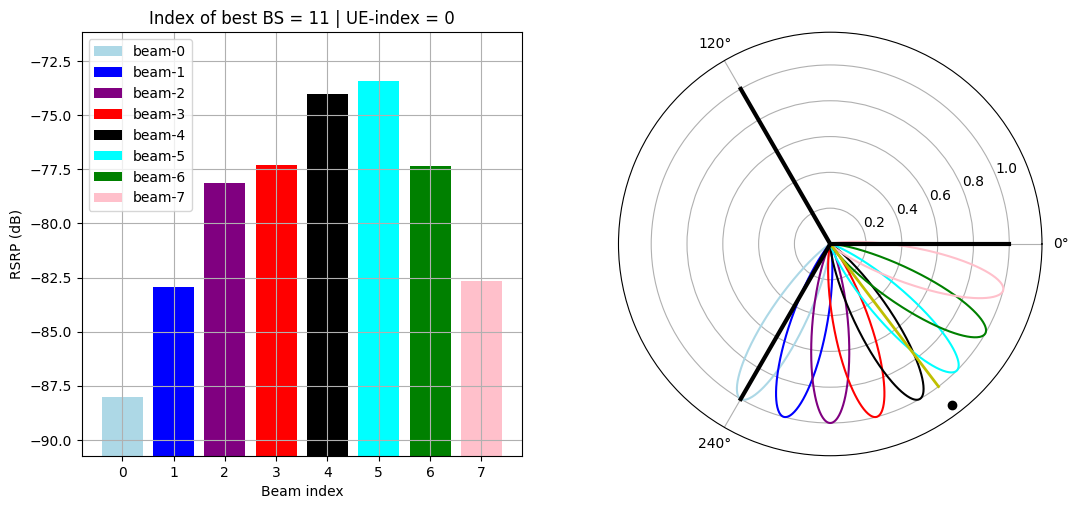P1 Procedure: Beam management in 5G networks using SSB
The P1 procedure, also known as the beam management procedure, is a mechanism used in 5G networks to facilitate efficient beam selection and management for communication between the base station (gNB) and user equipment (UE). Specifically, the P1 procedure focuses on the selection and tracking of the strongest beam from a set of possible beams transmitted by the gNB, known as the Secondary Synchronization Signal (SSB) beams.
Import librariers
Import Python libraries
[1]:
# %matplotlib widget
import matplotlib.pyplot as plt
import os
os.environ["CUDA_VISIBLE_DEVICES"] = "-1"
os.environ['TF_CPP_MIN_LOG_LEVEL'] = '3'
import numpy as np
# from IPython.display import display, HTML
# display(HTML("<style>.container { width:90% !important; }</style>"))
Import 5G Toolkit libraries
[2]:
import sys
sys.path.append("../../../")
from toolkit5G.SequenceGeneration import PSS, SSS, DMRS
from toolkit5G.PhysicalChannels import PBCH, PBCHDecoder
from toolkit5G.ResourceMapping import SSB_Grid, ResourceMapperSSB
from toolkit5G.ChannelModels import AntennaArrays, SimulationLayout, ParameterGenerator, ChannelGenerator
from toolkit5G.OFDM import OFDMModulator, OFDMDemodulator
from toolkit5G.ChannelProcessing import ApplyChannel, AddNoise
from toolkit5G.MIMOProcessing import AnalogBeamforming, ReceiveCombining
from toolkit5G.ReceiverAlgorithms import PSSDetection, SSSDetection, ChannelEstimationAndEqualization, DMRSParameterDetection
from toolkit5G.ReceiverAlgorithms import ChannelEstimationAndEqualizationPBCH
from toolkit5G.Configurations import TimeFrequency5GParameters, GenerateValidSSBParameters
Simulation Parameters
[3]:
terrain = "UMa" # Terrain # Propagation Scenario or Terrain for BS-UE links
carrierFrequency = 3.6*10**9 # Carrier frequency 3.6 GHz
scs = 30*10**3 # Subcarrier Spacing
nBatches = 10 # Number of Batches considered for simulation
numRBs = 40 # Please don't change this. The simulation will break down
Bandwidth = 10*10**6 # System bandwidth
Nfft = 512 # FFT-size
bandwidthTx = 10*(10**6); # Transmission bandwidth
nSymbolFrame = 140*int(scs/15000); # Number of OFDM symbols per frame (Its a function of subcarrier spacing)
nBSs = 21 # number of BSs
nUEs = nBatches # number of UEs
txAntStruture = np.array([1,1,4,4,2]) # Tx Antenna Structure
rxAntStruture = np.array([1,1,2,2,1]) # Rx Antenna Structure
Nt = txAntStruture.prod()
Nr = rxAntStruture.prod()
print()
print(" Terrain: "+terrain)
print(" Carrier Frequency: "+str(carrierFrequency/10**9)+" GHz")
print(" Subcarrier-Spacing: "+str(scs)+" kHz")
print(" Bandwidth: "+str(Bandwidth/10**6)+" MHz")
print(" FFT-size: "+str(Nfft))
print("Number of Resource Blocks: "+str(nBatches))
print("Number of User Equipments: "+str(nUEs))
print(" Number of Base Stations: "+str(nBSs))
print(" Number of Base Antennas: "+str(Nt))
print(" Number of UE Antennas: "+str(Nr))
print()
Terrain: UMa
Carrier Frequency: 3.6 GHz
Subcarrier-Spacing: 30000 kHz
Bandwidth: 10.0 MHz
FFT-size: 512
Number of Resource Blocks: 10
Number of User Equipments: 10
Number of Base Stations: 21
Number of Base Antennas: 32
Number of UE Antennas: 4
Generate Wireless Channel
[4]:
# Antenna Array at UE side
# assuming antenna element type to be "OMNI"
# with 2 panel and 2 single polarized antenna element per panel.
ueAntArray = AntennaArrays(antennaType = "OMNI", centerFrequency = carrierFrequency, arrayStructure = rxAntStruture)
ueAntArray()
# # Radiation Pattern of Rx antenna element
# ueAntArray.displayAntennaRadiationPattern()
# Antenna Array at BS side
# assuming antenna element type to be "3GPP_38.901", a parabolic antenna
# with 4 panel and 4 single polarized antenna element per panel.
bsAntArray = AntennaArrays(antennaType = "3GPP_38.901", centerFrequency = carrierFrequency, arrayStructure = txAntStruture)
bsAntArray()
# # Radiation Pattern of Tx antenna element
# bsAntArray[0].displayAntennaRadiationPattern()
# # Node Mobility
# timeInterval = 15/scs # number of SnapShots
# timeInst = np.linspace(0, timeInterval, 14)
# UEroute = NodeMobility("randomWalk", numUEs, timeInst, 1, 1, -0.7853981633974483, 0.7853981633974483, False)
# UEroute()
# fig, ax = UEroute.displayRoute()
# ax.set_aspect(True)
# Layout Parameters
isd = 500 # inter site distance
minDist = 35 # min distance between each UE and BS
ueHt = 1.5 # UE height
bsHt = 25 # BS height
bslayoutType = "Hexagonal" # BS layout type
ueDropType = "Hexagonal" # UE drop type
htDist = "equal" # UE height distribution
ueDist = "equal" # UE Distribution per site
nSectorsPerSite = 3 # number of sectors per site
maxNumFloors = 1 # Max number of floors in an indoor object
minNumFloors = 1 # Min number of floors in an indoor object
heightOfRoom = 3 # height of room or ceiling in meters
indoorUEfract = 0#0.5 # Fraction of UEs located indoor
lengthOfIndoorObject = 3 # length of indoor object typically having rectangular geometry
widthOfIndoorObject = 3 # width of indoor object
forceLOS = True # boolen flag if true forces every link to be in LOS state
# forceLOS = False # boolen flag if true forces every link to be in LOS state
# simulation layout object
simLayoutObj = SimulationLayout(numOfBS = nBSs,
numOfUE = nUEs,
heightOfBS = bsHt,
heightOfUE = ueHt,
ISD = isd,
layoutType = bslayoutType,
ueDropMethod = ueDropType,
UEdistibution = ueDist,
UEheightDistribution = htDist,
numOfSectorsPerSite = nSectorsPerSite,
ueRoute = None,
force3GPPSpatialConsistencyParameters = True,
enableSpatialConsistencyLoS = True)
simLayoutObj(terrain = terrain,
carrierFreq = carrierFrequency,
ueAntennaArray = ueAntArray,
bsAntennaArray = bsAntArray,
indoorUEfraction = indoorUEfract,
lengthOfIndoorObject = lengthOfIndoorObject,
widthOfIndoorObject = widthOfIndoorObject,
forceLOS = forceLOS)
simLayoutObj.linkState = simLayoutObj.linkState*False
# displaying the topology of simulation layout
fig, ax = simLayoutObj.display2DTopology()
# paramGen = simLayoutObj.getParameterGenerator(delaySpread=100*(10**(-9)),
# enableAbsoluteDelays=True,
# enableSpatialConsistencyForLSPs = True,
# enableSpatialConsistencyForSSPs = True,
# enableSpatialConsistencyForInitialPhases = True)
paramGen = simLayoutObj.getParameterGenerator(delaySpread=100*(10**(-9)))
#paramGen.displayClusters((0,0,0), rayIndex = 5)
channel = paramGen.getChannel()
Hf = channel.ofdm(scs, Nfft)
Nt = bsAntArray.numAntennas # Number of BS Antennas
Nr = ueAntArray.numAntennas
print(" Number of BSs: "+str(nBSs))
print(" Shape of Channel: "+str(Hf.shape))
print("*****************************************************")
print()

Number of BSs: 21
Shape of Channel: (1, 1, 21, 10, 512, 4, 32)
*****************************************************
Generate Time Frequency Parameters and MIB+ATI Parameters
[5]:
## This class fetches valid set of 5G parameters for the system configurations
tfParams = TimeFrequency5GParameters(Bandwidth, scs, fftsize=Nfft)
tfParams(nSymbolFrame, typeCP = "normal")
nRB = tfParams.numRBs # SSB Grid size (Number of RBs considered for SSB transition)
Neff = tfParams.Neff # Number of resource blocks for Resource Grid ( exclude gaurd band | offsets : BWP)
Nfft = 512 # FFT-size for OFDM
lengthCP = tfParams.lengthCP # CP length
lamda = 3e8/carrierFrequency;
nSCSOffset = 1
ssbParameters = GenerateValidSSBParameters(carrierFrequency, nSCSOffset, ssbType="caseA",
nssbCandidatesInHrf = 8, isPairedBand = False,
withSharedSpectrumChannelAccess = False)
systemFrameNumber = ssbParameters.systemFrameNumber
subCarrierSpacingCommon = ssbParameters.subCarrierSpacingCommon
ssbSubCarrierOffset = ssbParameters.ssbSubCarrierOffset
DMRSTypeAPosition = ssbParameters.DMRSTypeAPosition
controlResourceSet0 = ssbParameters.controlResourceSet0
searchSpace0 = ssbParameters.searchSpace0
isPairedBand = ssbParameters.isPairedBand
nSCSOffset = ssbParameters.nSCSOffset
choiceBit = ssbParameters.choiceBit
ssbType = ssbParameters.ssbType
nssbCandidatesInHrf = ssbParameters.nssbCandidatesInHrf
ssbIndex = ssbParameters.ssbIndex
hrfBit = ssbParameters.hrfBit
cellBarred = ssbParameters.cellBarred
intraFrequencyReselection = ssbParameters.intraFrequencyReselection
withSharedSpectrumChannelAccess = ssbParameters.withSharedSpectrumChannelAccess
nFrames = 0.5
Nsc_ssb = 240
Nsymb_ssb = 4
#_______________________________________
Generate OFDM Resource/Transmission Grid
[6]:
numSymbols = 56
Pt = 53
nID2 = np.arange(3)
nID1 = np.arange(7)
bwpOffset = np.random.randint(Nfft - numRBs*12)
azimuth = np.linspace(0, 2*np.pi/3, nssbCandidatesInHrf, endpoint=False)
secAngle = np.arange(nSectorsPerSite)*(2*np.pi/3)
theta = 75*np.pi/180
antLocations = bsAntArray.locations[0,0].reshape(-1,3)
ssbPositionInBurst = np.ones(nssbCandidatesInHrf, dtype=int)
# Generate SSB
ssb = np.zeros((21, 8, 4, 240), dtype=np.complex64)
Xf = np.zeros((nBSs, Nt, numSymbols, Nfft), dtype = np.complex64)
for nbs in range(nBSs):
cellID1 = int(nbs/3)
cellID2 = int(nbs%3)
# Generate PSS sequence
pssObject = PSS(cellID2)
pssSequence = pssObject()
# Generate SSS sequence
sssObject = SSS(cellID1, cellID2)
sssSequence = sssObject()
ssbIndex = np.arange(nssbCandidatesInHrf)
# Generate DMRS sequence
dmrsLen = 144;
dmrsObject = DMRS("PBCH", nbs, ssbIndex, nssbCandidatesInHrf, hrfBit)
dmrsSequence = dmrsObject(dmrsLen)
pbchObject = PBCH(carrierFrequency, choiceBit, subCarrierSpacingCommon, DMRSTypeAPosition,
controlResourceSet0, searchSpace0, cellBarred,
intraFrequencyReselection, systemFrameNumber, ssbSubCarrierOffset,
hrfBit, ssbIndex, nbs, nssbCandidatesInHrf)
pbchSymbols = pbchObject()
ssbObject = SSB_Grid(nbs)
ssb[nbs] = ssbObject(pssSequence, sssSequence, dmrsSequence, pbchSymbols)
ssbRGobject = ResourceMapperSSB(ssbType, carrierFrequency, isPairedBand, withSharedSpectrumChannelAccess)
ssbGrid = ssbRGobject(ssb[nbs], ssbPositionInBurst, offsetInSubcarriers = ssbSubCarrierOffset[0],
offsetInRBs = 0, numRBs = numRBs)
for nbm in range(nssbCandidatesInHrf):
phi = azimuth[nbm] + secAngle[nbs%nSectorsPerSite]
steeringVector = np.stack((np.sin(theta, dtype = np.float32)*np.cos(phi, dtype = np.float32),
np.sin(theta, dtype = np.float32)*np.sin(phi, dtype = np.float32),
np.cos(theta, dtype = np.float32)), axis = -1)[...,np.newaxis]
beamVectors = ((simLayoutObj.BSLocations[[nbs]] + antLocations)@steeringVector)/lamda
beamVectors = np.sqrt(Pt/Nt)*np.exp(-1j*2*np.pi*beamVectors)
n = ssbRGobject.symbolIndices[nbm]
Xf[nbs,:,n:n+4,bwpOffset:bwpOffset+numRBs*12] = beamVectors[...,np.newaxis]*ssbGrid[np.newaxis,n:n+4]
fig, ax = ssbObject.displayGrid()

Pass through the Wireless Channel
[7]:
# Pass through Channel
Y = (Hf[0,0,:,:,np.newaxis]@Xf.transpose(0,2,3,1)[:,np.newaxis,...,np.newaxis])[...,0]
Power Heatmap of Received Grid
[8]:
ui = np.random.randint(nUEs)
bi = np.random.randint(nBSs)
ai = np.random.randint(Nr)
fig, ax = plt.subplots()
ax.imshow(np.abs(Y[bi,ui,:,:,ai].T), cmap = "hot", interpolation= "nearest", aspect='auto', origin = "lower")
plt.show()

Add Noise
[9]:
BoltzmanConst = 1.380649*(10**(-23))
temperature = 300
noisePower = BoltzmanConst*temperature*numRBs*scs
kppm = 0
fCFO = kppm*(np.random.rand()-0.5)*carrierFrequency*(10**(-6)); # fCFO = CFO*subcarrierSpacing
CFO = (fCFO/scs)/Nfft
Yf = np.complex64(AddNoise(False)(Y, noisePower, 0)) #Added
RSRP Computation
[10]:
# Rx Beamforming
numRxBeams = 8
combiner = np.fft.fft(np.eye(numRxBeams))[:,0:Nr]
ssbEsti = np.zeros((nBSs, nUEs, nssbCandidatesInHrf, 4, 240, numRxBeams), dtype = np.complex64)
ssbEst = np.zeros((nUEs, 4, 240), dtype = np.complex64)
rsrp = np.zeros((nBSs, nUEs, nssbCandidatesInHrf))
for nbm in range(nssbCandidatesInHrf):
n = ssbRGobject.symbolIndices[nbm]
ssbEsti[:,:,nbm] = (combiner.reshape(1,1,1,1,1,numRxBeams,Nr)@Yf[:,:,n:n+4,ssbSubCarrierOffset[0]:ssbSubCarrierOffset[0]+240,:, np.newaxis])[...,0]
rsrp[:,:,nbm] = 10*np.log10((np.abs(ssbEsti[:,:,nbm,2,56:183])**2).mean(-2).max(-1)) + 30
bestBeams = rsrp.argmax(-1)
[11]:
rsrp.shape
[11]:
(21, 10, 8)
Visualization of All Beam RSRP
[12]:
ueIndex = 0
[13]:
fig, ax = plt.subplots(layout='constrained', figsize = (15,5))
color = ['lightblue', 'blue', 'purple', 'red', 'black', 'cyan', 'green', 'pink']
label = ["beam-0", "beam-1", "beam-2", "beam-3", "beam-4", "beam-5", "beam-6", "beam-7"]
width = 0.075
minVal = -10*np.floor(rsrp[:,ueIndex].min()/10)
for nb in range(nBSs-1):
rects = ax.bar(0.1*np.arange(nssbCandidatesInHrf) + nb - 0.35, rsrp[nb,ueIndex]+minVal, width, bottom = rsrp[:,ueIndex].min(), color = color)
nb = nBSs-1
rects = ax.bar(0.1*np.arange(nssbCandidatesInHrf) + nb - 0.35, rsrp[nb,ueIndex]+minVal, width, bottom = rsrp[:,ueIndex].min(), color = color, label = label)
ax.legend()
ax.set_xticks(np.arange(nBSs), minor=False)
ax.vlines(np.arange(nBSs+1) - 0.5, ymin = rsrp[:,ueIndex].min(), ymax = rsrp[:,ueIndex].max()+10)
ax.set_xlim([-0.5, 21])
ax.set_ylim([rsrp[:,ueIndex].min(), rsrp[:,ueIndex].max() + 10])
ax.set_xlabel("BS-Index")
ax.set_ylabel("RSRP (dB)")
ax.grid()
plt.show()

Selected Base-station and Beam
[16]:
fig = plt.figure(figsize = (12.5, 5.5))
ax1 = plt.subplot(121)
ax2 = plt.subplot(122, projection='polar')
width = 0.8
idx = np.argwhere(rsrp[:,ueIndex] == np.max(rsrp[:,ueIndex]))
nb = idx[0][0]
rects = ax1.bar(np.arange(nssbCandidatesInHrf), rsrp[nb,ueIndex]+minVal, width, bottom = rsrp[:,ueIndex].min(), color = color, label = label)
ax1.legend()
ax1.set_xticks(np.arange(nssbCandidatesInHrf), minor=False)
ax1.set_ylim([rsrp[nb,ueIndex].min(), rsrp[nb,ueIndex].max() + 5])
ax1.set_xlabel("Beam index")
ax1.set_ylabel("RSRP (dB)")
ax1.set_title("Index of best BS = "+str(nb)+" | UE-index = "+str(ueIndex))
ax1.grid()
numPoints = 1000
numBeams = 8
order = 32
theta = np.linspace(-0.5*np.pi, 0.5*np.pi, numPoints)
beamAngle = np.linspace(0, 2*np.pi/3, numBeams, endpoint=False) + (nb%3)*2*np.pi/3
for nbeam in range(numBeams):
ax2.plot(beamAngle[nbeam] + theta, np.cos(theta)**order, zorder = 3, color = color[nbeam])
refLocation = simLayoutObj.UELocations[ueIndex] - simLayoutObj.BSLocations[nb]
radius = 2*np.linalg.norm(refLocation)/isd
phi = np.arctan2(refLocation[1], refLocation[0])
ax2.plot(phi, radius, "k", marker='o', lw = 100, zorder = 4)
ax2.set_rmax(1)
ax2.plot([phi,phi], [0,1], "y", lw = 2, zorder = 4)
ax2.plot([2*np.pi/3,2*np.pi/3], [0,1], "k", lw = 3, zorder = 4)
ax2.plot([4*np.pi/3,4*np.pi/3], [0,1], "k", lw = 3, zorder = 4)
ax2.plot([0,0], [0,1], "k", lw = 3, zorder = 4)
# ax.set_rticks([0.25, 0.5, 0.75, 1]) # Less radial ticks
# ax.set_rlabel_position(-22.5) # Move radial labels away from plotted line
ax2.set_thetagrids(np.arange(0,3)*120)
plt.show()

Simulation Topology
[15]:
fig, ax = simLayoutObj.display2DTopology(displayPlot=False)
ax.scatter(simLayoutObj.UELocations[ueIndex,0], simLayoutObj.UELocations[ueIndex,1], color = "cyan", s = 100, zorder = 20)
ax.scatter(simLayoutObj.BSLocations[nb,0], simLayoutObj.BSLocations[nb,1], color = "k", s = 450, zorder = 21)
plt.show()

[ ]: